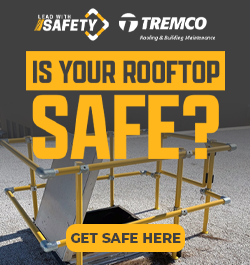Fall Protection for Roofing Workers

Fall protection doesn’t need to be difficult, and focusing on preventing a fall is important.
When working on an exterior home design project there are few areas as dangerous as the roof. When you get multiple workers within a small area, as well as tools and construction materials, and equipment like ladders and aerial lifts being used, one slip can lead to a fatal fall. Fall protection doesn’t need to be difficult, and focusing on preventing a fall is important.
OSHA, or the Occupational Safety and Health Administration, is the best source when it comes to fall protection instruction and overall worker safety when it comes to roofs. You can find plenty of guides through OSHA, including those specific to roof work. It is highly recommended that contractors become OSHA certified.
Some important fall prevention standards to keep in mind include:
- The use of a safety harness if 6’+ off the ground
- Using an anchorage system with 5,000 lbs of support per worker
- Any equipment that has been stressed or prevented a fall be retired immediately
- Use of guardrail systems if applicable
- Having a competent worker serve as a safety monitor
- Training all workers on how to properly set up and to safely climb ladders
- Only professionally designed and constructed scaffolding be used
- Toeboards are used along roof edges to prevent tools or materials from rolling/falling off the roof if dropped
- Proper non-slip footwear be worn by anyone on the roof
- Only properly trained workers to be allowed to control aerial lifts
Not all contractors may use OSHA training but it is highly recommended that their safety standards are taken seriously. Even homeowners who may go onto their roof for cleaning or other reason understand when and how to use safety equipment.
It is important that contractors use reliable, experienced workers on roofing projects, and that these workers are trained in fall prevention and safety. New crew members in training should be carefully monitored and not put into situations where a mistake could lead them or another worker into harm’s way.
Safety equipment for roof workers
The choice of safety equipment is directly related to fall protection. Not only is their specialized equipment for roof worker safety, but contractors should also ensure that the regular equipment their crews are using is safe. For example, falls while climbing on a ladder are common and reducing the chance of a fall can be reduced by using new, sturdy ladders as well as properly training workers.
For roofing work, there are two options for safety equipment – a personal arrest system and roof brackets. A personal fall arrest system is a safety harness setup designed to prevent falls and keep workers safe. As mentioned before this harness should be used on any structure where workers are 6′ or more off the ground. These personal arrest systems should only use certified harnesses which support the whole body. Cheap body belts should never be used as they are not safe and could cause severe injury if a worker does fall. Harness should be sized for each individual worker. Each worker should be trained on how to put them on, adjust the size and attach to an anchorage system.
The second useful type of safety equipment specific to roof work is roof brackets. Roof brackets are durable metal brackets combined with metal or thick wood boards placed temporarily on the roof. These brackets are angled with the roof and help prevent falls in two ways – one, by giving workers a place to brace their feet, and two, by giving a foothold or handhold if a fall happens.
Fall protection for flat roofs
It happens all too often that contractors or their workers believe that working on a flat roof is safer, and therefore safety precautions are ignored. While the chances of falling from a flat roof is rarer than an angled one, the chance for injury is still there. Fall prevention is just as important, even if the workers aren’t actually roofing but perhaps are installing a rooftop deck instead.
Using a personal fall arrest system is usually a bit much for most flat roof work, especially on single-story buildings, but guardrails are recommended. Metal guardrails are easy to put up temporarily for construction, serving as both a visual and physical barrier to the roof’s edge. When roof workers are purely focused on the task at hand it can be easy to forget just how close the roof edge is. Even a simple red or orange tape around the perimeter of the roof can help prevent falls by reminding workers of how close the edge is.
Fall protection is an important part of roof worker safety, as well as the safety for those that are around the construction site. It is highly recommended that anyone that is working on a roof to be properly trained on roofing safety procedures and to use OSHA-recommended safety equipment, even if they are working on a residential property. Contractors should take the initiative to make sure their crews are up to date on safety techniques and homeowners should also ensure that any crew members working on their work are using safe practices.
Have a question? AskARoofer.
Find your local roofing contractor in the RoofersCoffeeShop® Contractor Directory.










Comments
Leave a Reply
Have an account? Login to leave a comment!
Sign In